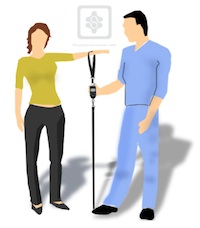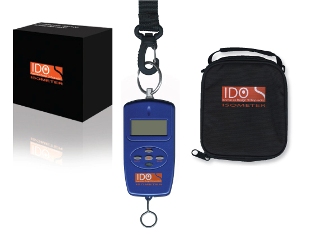Constant Score Technique
BACKGROUND
The European Society for Shoulder and Elbow Surgery (ESSES) adopted the scoring system of C Constant and A Murley [1, 2, 3, 4, 5].
This scoring system consists of four variables that are used to assess the function of the shoulder. The right and left shoulders are assessed separately.
The subjective variables are pain and ADL (sleep, work, recreation / sport) which give a total of 35 points.
The objective variables are range of motion and strength which give a total of 65 points.
| SUBJECTIVE | |
| Pain | 15 |
| ADL (sleep, work, recreation/sport) | 20 |
| OBJECTIVE | |
| Range of motion | 40 |
| Strength | 25 |
RANGE OF MOTION
Active range of motion should always be measured as part of the Constant Score.
ESSES recommends measuring range of motion with the patient sitting on a chair or bed, with weight even distributed between the ischial tuberosities. No rotation of the upper body may take place during the examination.
In the case of active motion, the patient lift his arm to a painfree level. Note that the number of degrees at which the pain starts determines the range of motion. If one measures the active range of motion with pain, this should be stated. The Constant score cannot then be applied beyond the initiation of pain.
The most important thing is that range of motion is performed and measured in a standardised way.
In the Constant score system there is precise information about how the points are calculated. Bear in mind that 150 degrees of flexion give 8 points, while 151 degrees give 10 points.
| Forward flexion 10 points | ||
| 0-30 | 0 | |
| 31-60 | 2 | |
| 61-90 | 4 | |
| 91-120 | 6 | |
| 121-150 | 8 | |
| 151-180 | 10 | |
| Abduction 10 points | ||
| 0-30 | 0 | |
| 31-60 | 2 | |
| 61-90 | 4 | |
| 91-120 | 6 | |
| 121-150 | 8 | |
| 151-180 | 10 | |
| External rotation 10 points (hand is not allowed to touch the head) | ||
| Not reaching the head | 0 | |
| Hand behind head with elbow forward | 2 | |
| Hand behind head with elbow back | 2 | |
| Hand on top of head with elbow forward | 2 | |
| Hand on top of head with elbow back | 2 | |
| Full elevation from on top of head | 2 | |
| Internal rotation 10 points | ||
| End of the thumb to lateral thigh | 0 | |
| End of the thumb to buttock | 2 | |
| End of the thumb to lumbosacral junction | 4 | |
| End of the thumb to L3 (waist) | 6 | |
| End of the thumb to T 12 | 8 | |
| End of the thumb to T 7(interscapular) | 10 | |
STRENGTH
Strength is given a maximum of 25 points in the Constant Score. The significance and technique of strength measurement has been, and continues to be, the subject of much discussion.
The European Society for Shoulder and Elbow Surgery measures strength according to the following method:
- A spring balance is attached distal on the forearm.
- Strength is measured with the arm in 90 degrees of elevation in the plane of the scapula (30 degrees in front of the coronal plane) and elbow straight.
- Palm of the hand facing the floor ( pronation ).
- The patient is asked to maintain this resisted elevation for 5 seconds.
- It is repeated 3 times immediately after another.
- The average in pound ( lb ) is noted.
- The measurement should be painfree. If pain is involved the patient gets 0 points.
- If patient is unable to achieve 90 degrees of elevation in the scapula plane the patient gets 0 points.
Devices for Measuring Strength:
Strength can be measured with a standard Spring Balance (available from Fishing stores) or specific commercial devices.
Easy and small spring balances are available online and good value online. You will need one that has 25lb/12Kg capacity. A good digital one is the Salter Electro
We prefer the IDO Isometer from IDO, which has been designed specifically for Constant score strength testing of the shoulder. It is small, light and uses disposable batteries. It is provided in an excellent portable bag, with options for fixed attachment to furniture or underfoot. The booklet explains the technique clearly and it is very simple and quick to use. This device was developed by Prof. Ofer Levy and is available to purchase online at www.idorth.com

QUALITY ASSURANCE
It is essential that the measurement of all variables is standardised. When making any adjustments, such as using Age or Sex adjustments this should be mentioned. This also should apply when normalising the data.
REFERENCES
| 1. | Constant C R, Murley A H G. A clinical method of functional assessment of the shoulder. Clinical Orthopaedics and Related Research 1987; 214: 160-164. |
| 2. | Constant C R. Assessment of the shoulder. In: Watson M. Surgical disorders of the shoulder. Churchill Livingstone, New York. 1991; 39-45. |
| 3. | Constant C R. Constant Scoring Technique for Shoulder Function. SECEC information. 1991. Nr 3 |
| 4. | Gerber C. Integrated Scoring Systems for the Functional Assessment of the Shoulder. In: Matsen F, Fu F, Hawkins (red). The Shoulder: A Balance of Mobility and Stability. Rosemont, 1992; 531-50. |
| 5. | Circular to members of British Shoulder and Elbow Society. 1997. |


